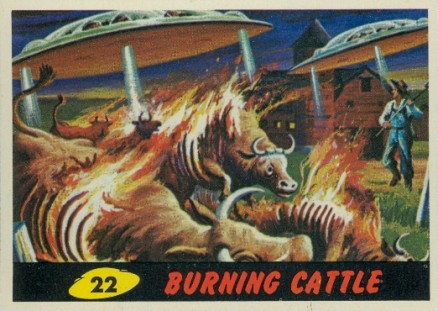As a parody of 1950's B-movies, Mars Attacks! chooses to focus more upon parodying specific scenes and sequences from individual films, in particular Earth vs the Flying Saucers. This is particularly evident in the sequence where a flying saucer shoots the Washington Monument and in an attempt to crush some school children; this is a parody of the scene in Earth vs the Flying Saucers where a flying saucer crashes into the Monument, causing it to fall towards a group of civilians
Film 1: Earth vs the Flying Saucers Trailer*
Filmography
List of Illustrations
Bibliography
Other references to Earth vs the Flying Saucers include the design of the Martian Saucers (especially the location and design of the "death ray"; and the opening scene's soundtrack's mix of standard orchestra and etherial electronic music.
Film 2: #02 Mars Attacks! - Main Titles
The plot of the film is based upon a set of trading cards (which also provide the films title); these cards depict the invasion of earth by hostile aliens from Mars and the subsequent military response. These cards also provide the design of the film's Martians, as well as a number of sequences. These include the opening scene of a herd of stampeding burning cattle (Card 22) and the giant robot attack (Card 32). Unfortunately, basing the plot upon a series of trading cards can leave it feeling somewhat disconnected, a situation not helped by the film's focus upon 3 main groups of characters spread around the USA. The basic story is a fairly standard 1950's alien invasion film, with one or two cliche reversals for comic effect (notably, the human's enduring belief that the aliens have come in peace, and all of the attacks are in fact due to cultural differences).
Fig 1. Mars Attacks! Card #22 : Burning Cattle
Fig 2. Mars Attacks! Card #32 : Robot Terror
When first conceived, the film was inteneded to use traditional stop-motion animation for almost all of it's special effects, in homage to the 1950's B-movies that it parodies. However, the technical difficulties involved in the large number of effects meant that a decision was made to switch to digital (CGI) effects, although these effects were designed to look as similar to real stop-motion effects as possible. At the same time, the life-sized alien models that had already been constructed for the "traditional" special effects were put to use as alien corpses, giving the actors something real to interact with, which helps end an air of authenticity. Another unusual special-effect moment is the incorporation of stock footage of "The Landmark Hotel and Casino" in Las Vegas as part of the destruction visited upon the city by aliens; the technique of incorporating stock footage into a film (either with or without added special effects) was common in 1950s B-Movies.
Much of the films success is based upon its creation of a retro 1950s atmosphere, an effect that is down to extremely high production values and set design. This includes aspects such as the use of only period-correct vehicles, small, CRT based televisions, and the primitive nature of the human technology (in particular the tape-based universal translating machine). This helps to contrast with the alien's advanced technology (which also posseses a retro 1950s feel). However, one area in which the films production values fall below its 1950s ancestors is in military equipment. Whilst the original 1950's films featured accurate period military equipment (usually through a combination of stock footage and military surplus equipment from world war 2, although The Day the Earth Stood Still used the Washington National Guard), Mars Attacks! features prominent anachronisms in the form of Soviet T-55 tanks painted in american colours alongside actual American tanks.
Fig 3. Mars Attacks! [Film still]
* Washington Monument Sequence begins at 2:00 mark
Filmography
Film 1. Earth vs The Flying Saucers Trailer (2006) http://www.youtube.com/watch?v=2o4fdX8gUMY (Accessed on 24/12/2011)
Film 2. #02 Mars Attacks! - Main Titles (2010) http://www.youtube.com/watch?v=pzI71Ged1aU (Accessed on 27/12/2011)
List of Illustrations
Figure 1. Mars Attacks! Card #22 : Burning Cattle (1962) At: http://www.vintagecardprices.com/pics/3265/189958.jpg (Accessed on 30/12/2011)
Figure 2. Mars Attacks! Card #32 : Robot Terror (1962) At: http://3.bp.blogspot.com/-RFYZK6WOexw/Tr1csQAjGdI/AAAAAAAAILY/m-fVuR6mkwY/s1600/robot32.jpg (Accessed on 30/12/2011)
Figure 3. Mars Attacks! [Film Still] At: http://www.imcdb.org/i221814.jpg (Accessed on 01/01/2012)
Figure 3. Mars Attacks! [Film Still] At: http://www.imcdb.org/i221814.jpg (Accessed on 01/01/2012)
Bibliography
IMDb.com (1996) Mars Attacks! (1996) [Online] At: http://www.imdb.com/title/tt0116996/ (Accessed on 18/12/2011)
Jones, K. R. (1996) Mars Attacks!: the Art of the Movie Titan Books
Maslin, J (1996) Mars Attacks! (1996) In: The New York Times [Online] At: http://movies.nytimes.com/movie/review?res=9F04EEDA173EF930A25751C1A960958260&partner=Rotten%20Tomatoes (Accessed on 22/12/2011)
McCarthy, T (1996) Mars Attacks! In: Variety.com [Online] At: http://www.variety.com/review/VE1117436916?refcatid=31 (Accessed on 20/12/2011)


















































